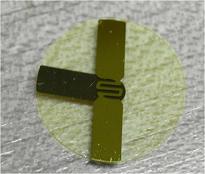| * |
|
Resonating Platforms for Nanomaterial Analysis
Summary:Our goal is to develop quartz crystal microbalance (QCM) instrumentation and advanced oscillators with enhanced sensitivity to address characterization of nanoparticles, including their interactions with the environment. Examples include: nanoparticle-based water remediation; nanoparticle purity and quality control; and nanoparticle uptake in biological systems. Our focus is on smaller sample volumes, which will decrease the cost of materials analysis and enable more rapid collection of statistically significant data populations. Description:Quartz crystal microbalances (QCM) are highly sensitive acoustic devices capable of monitoring sub-picogram mass changes in rigid coatings and thin films. Devices are typically comprised of a thin, piezoelectric, AT-cut, quartz crystal sandwiched between two metal excitation electrodes. When an AC voltage is applied to the electrodes, the quartz crystal oscillates at a characteristic frequency based on the crystal geometry, referred to as the resonant frequency. Any perturbation of the crystal surface (e.g., adsorbed mass) alters this characteristic frequency. To determine mass changes in the material coating, we monitored the resonance frequency of the quartz crystal using an impedance analyzer. During coating deposition, the resonance frequency decreases, with the shift in frequency directly proportional to the change in mass. On heating, the coating mass decreases due to oxidation of the material, resulting in an increase in resonance frequency. We have developed an elevated temperature QCM technique that interrogates samples on the order of 1 microgram or less. This elevated temperature platform allows for thermogravimetric measurements to be made on samples 1000 times smaller above than commercially available thermogravimetric analysis (TGA), resulting in cheaper, rapid collection of statistically significant populations of data for monitoring nanoparticle purity. QCM measurements on nanoparticles in aqueous environments are being used to determine the feasibility of nanoparticle use in water remediation. Major Accomplishments:
|
 End Date:OngoingLead Organizational Unit:mmlFacilities/Tools Used:
Staff:Related Programs and Projects:Associated Products:Project Summary (PDF) Contact
Elisabeth Mansfield |



